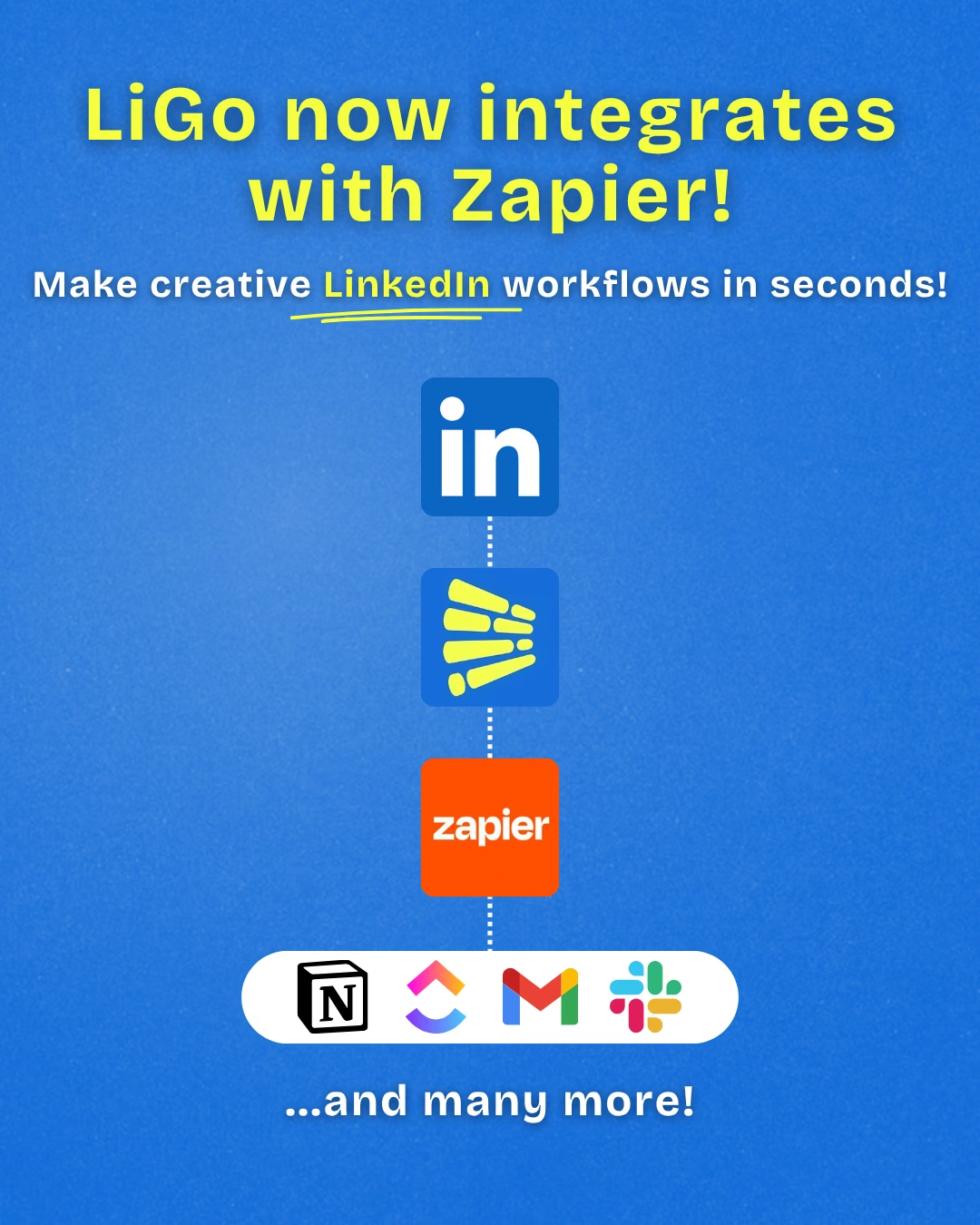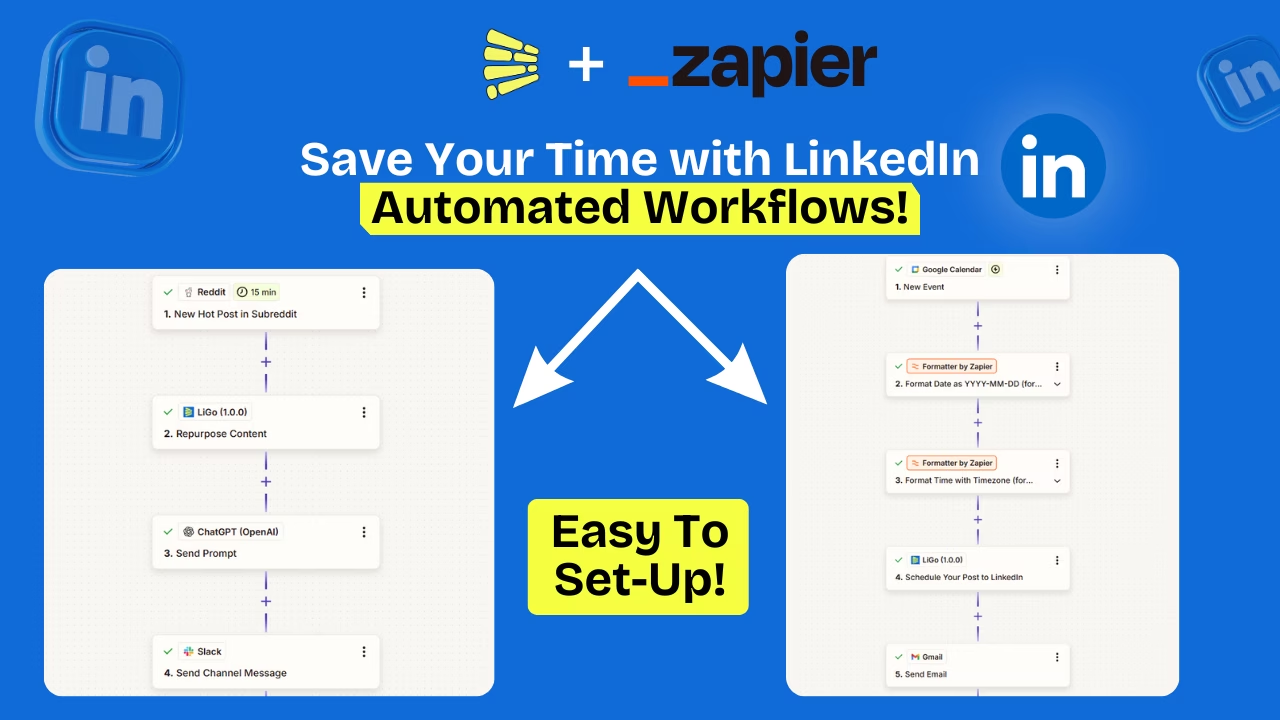Last updated: October 22, 2025
I want to walk you through one thing I care about more than fancy features: your time. Specifically, how much of it you spend doing the small, repeatable tasks that keep your LinkedIn presence alive - and how much of that can be reclaimed by connecting LiGo to Zapier.
I’ll map the manual time spent at each step of a typical LinkedIn content workflow and show the same step with LiGo + Zapier - side by side - so you can see the real time savings. I’ll also cover setup, example automations, troubleshooting, security, limits, pricing, and practical ways to insert the integration into your daily routine.

Why I Framed This As a Time-Audit
People talk about automations in two ways: features and feelings. Features are lists: "it can do X, Y, Z." Feelings are what matter: "will it save me time?" I pick time because time is measurable and because it's something everyone understands. If an integration truly saves you measurable minutes every week, it changes how you plan, how you create, and how you grow.
So I mapped a common LinkedIn content process step-by-step. For each step I estimated how long it takes manually and how long it takes with LiGo + Zapier automations. I'll show the math. You don't need to trust me - you can set it up and test it.
The Zapier help center is a good reference for setup and examples. Zapier Help Center
The Baseline: A Real, Manual LinkedIn Workflow (Typical Week)
Imagine this is you: you plan to post three times a week. Those posts go through ideation, drafting, editing, formatting, scheduling, and follow-up (tracking engagement and repurposing).
Here's a simplified manual breakdown I see people do:
- Collect ideas - searching feeds, saving interesting posts, jotting notes.
- Time: 30 minutes per week.
- Drafting - writing three posts, making sure each has an angle, hook, and CTA.
- Time: 60 minutes per week (about 20 minutes per post).
- Editing & formatting - breaking paragraphs, adding bold/italics, emojis, line breaks, manual links, hashtags.
- Time: 30 minutes per week (10 minutes per post).
- Scheduling - opening a scheduler, creating scheduled entries, setting times, confirming.
- Time: 15 minutes per week.
- Notifications & team updates - telling your team or clients about scheduled posts, uploading drafts to a folder, copying links.
- Time: 20 minutes per week.
- Repurposing / monitoring - transforming a good performing post into a thread, newsletter blurb, or short-form video plan.
- Time: 30 minutes per week.
- Solución de problemas (mistakes, broken links, missed images) - ad hoc, maybe 10 minutes a week.
Total manual time: 30 + 60 + 30 + 15 + 20 + 30 + 10 = 195 minutes per week.
That's three hours and fifteen minutes every week. Over a month (4 weeks) that's 780 minutes, which is 13 hours. You can do the digit math like this: 195 × 4 = 780 minutes. 780 divided by 60 = 13 hours.
Those hours add up fast. Now let's see the same process when we use LiGo + Zapier automations.
The Automated Workflow With LiGo + Zapier
When we connect LiGo to Zapier we can automate many of these steps. Here are the same stages using Zapier automations (zaps) I recommend.
All of the example zaps below and are ready to set up.
Example Automations I Use
Zap #1 - Calendar → LiGo → LinkedIn
Trigger: Google Calendar - New Event.
Action 1: LiGo - Schedule Post to LinkedIn.
Action 2: Gmail - Notify me when scheduled.
Purpose: turn time-blocked content planning into scheduled posts automatically.
Zap #2 - LiGo → Discord
Trigger: LiGo - New LinkedIn Post Scheduled.
Action: Discord - Send Channel Message.
Purpose: team notification without manual messages.
Zap #3 - ClickUp → LiGo
Trigger: ClickUp - New message (idea).
Action 1: LiGo - Create Post Idea.
Action 2: ClickUp - Create Task to review.
Purpose: capture ideas from teammates automatically.
Zap #4 - Reddit → LiGo → ChatGPT → Slack
Trigger: Reddit - New Hot Post in Subreddit.
Action 1: LiGo - Repurpose Content (create drafts)
Action 2: ChatGPT - Generate variations, pick best.
Action 3: Slack - Post best pick into channel.
Purpose: automated trend-to-content pipeline.
Those are the workflows I'll use in the audit below.
Time-audit: Manual Minutes vs Automated Seconds (Three-post Week Example)
I'll repeat the earlier workflow, but show the time when automations are in place. For each step I'll state manual time, automated time, and the saving.
- Collect ideas
- Manual: 30 minutes per week.
- Automated: Reddit / RSS / Slack → LiGo zaps capture ideas automatically. You'd still review - maybe 10 minutes per week.
- Saving: 20 minutes per week.
- Drafting
- Manual: 60 minutes per week.
- Automated: LiGo repurpose/AI drafts via Zap (ChatGPT step optional) - auto-drafts in LiGo, you edit. Realistic edit time: 20 minutes per week.
- Saving: 40 minutes per week.
- Editing & formatting
- Manual: 30 minutes per week.
- Automated: Use LiGo formatting presets + Zap that applies formatting when a post is created. Automated formatting takes seconds; you check for 5 minutes.
- Saving: 25 minutes per week.
- Scheduling
- Manual: 15 minutes per week.
- Automated: Calendar → LiGo zap schedules it automatically. Confirm in 1 minute.
- Saving: 14 minutes per week.
- Notifications & team updates
- Manual: 20 minutes per week.
- Automated: LiGo → Discord / Slack zap sends a channel message instantly. Confirm in 1 minute.
- Saving: 19 minutes per week.
- Repurposing / monitoring
- Manual: 30 minutes per week.
- Automated: LiGo repurpose zap drafts 3 variants. You pick/approve in 5 minutes.
- Saving: 25 minutes per week.
- Solución de problemas
- Manual: 10 minutes per week.
- Automated: Zapier task notifications and LiGo logs cut down debugging to 3 minutes (you still check the task history for failures).
- Saving: 7 minutes per week.
Now add them. Manual total we computed earlier at 195 minutes per week. Automated total:
- Collect ideas: 10
- Drafting: 20
- Editing & formatting: 5
- Scheduling: 1
- Notifications: 1
- Repurposing: 5
- Troubleshooting: 3
Sum: 10 + 20 = 30. 30 + 5 = 35. 35 + 1 = 36. 36 + 1 = 37. 37 + 5 = 42. 42 + 3 = 45 minutes per week.
So automated total = 45 minutes per week.
Net saving per week: 195 − 45 = 150 minutes saved.
Do the subtraction carefully: 195 minus 45: 195 − 40 = 155; 155 − 5 = 150 minutes.
150 minutes is 2 hours and 30 minutes saved each week. (150 ÷ 60 = 2.5 hours.)
Over a month (4 weeks), that's 600 minutes saved, equal to 10 hours reclaimed. (150 × 4 = 600; 600 ÷ 60 = 10.)
If you scale this across a team of 3 content owners doing similar work, that's 30 hours saved per month.
This is the practical math I use when I weigh the cost of a paid tool vs the time it frees. The LiGo Zapier integration is a paid LiGo feature, and for many teams the time savings quickly justify the cost.
Step-by-step: How To Set Up The Core Zaps (Simple & No Code)
I'll assume you have a paid LiGo account and an invite to the LiGo app in Zapier. If you don't yet, Click here to get your Zapier invitation link. The help article walks this through in detail.
1. Get your LiGo API key
You can get your API key from your account settings. Keep it safe, if compromised regenarate it from the same accout settings page.
2. Connect LiGo in Zapier
- In Zapier: My Apps → Add connection → search for LiGo.
- Paste the API key into the credentials field when prompted.
- Run the Zapier test for the connection. A successful test shows your LiGo account in My Apps. If you can't find LiGo, request an invite from support.
3. Calendar → LiGo (Schedule post)
- Trigger: Google Calendar → New Event.
- Map the event fields: title → LiGo post title, start date/time → scheduled_at (use a formatter if needed).
- Action: LiGo → Schedule Post to LinkedIn.
- Optional: Add Gmail action to notify you.
- Test: create a calendar event and confirm it appears in LiGo scheduled posts.
4. LiGo → Slack / Discord (Team notifications)
- Trigger: LiGo → New LinkedIn Post Scheduled.
- Action: Slack or Discord → Send Message to channel.
- Map post title, scheduled time, and a link to the post in the message body.
5. Repurpose automation (Reddit → LiGo → ChatGPT → Slack)
- Trigger: Reddit → New Hot Post in Subreddit.
- Action 1: LiGo → Repurpose Content (create drafts).
- Action 2: ChatGPT → Make 3 variants and choose one.
- Action 3: Slack → Post picked variant in channel for review.
That last one shows how Zapier connects tools and automates multi-step pipelines without code.

Troubleshooting & Zapier Support Tips
Below are practical tips from our help center and my own experience. If you get stuck, the LiGo help doc is a good place, but these tips speed things up.
- 401 Unauthorized - usually a bad API key. Re-copy from LiGo settings and re-test. Watch for extra spaces when you paste.
- No sample data - create a quick test event or sample post in the trigger app to force sample data into Zapier.
- Rate limit errors - reduce frequency, batch items, or check your LiGo plan usage.
- Task fails - check Zapier task history, then copy the request body and response body for support. Include a timestamp. This helps Zapier support and LiGo support reproduce the issue faster.
- Invite-only issue - can't find LiGo in Zapier app list? Click here to get your Zapier invitation link.
If you need Zapier support itself, use Zapier's Support and include the Zap name and a screenshot of the run history.
Security, Privacy, & Best Practices
- Treat your LiGo API key like a password. Do not share it publicly or hard-code it into public repos. If compromised, rotate/regenerate the key in LiGo settings.
- Use Zapier account-level sharing carefully. Share access only with trusted teammates.
- Start with a small test set before enabling a high-volume Zap in production. This avoids accidental spam or large task charges.
- Log request/response bodies for first-run debugging, then remove or redact logs that contain sensitive info.
Common Workflow Examples (Real Quick Recipes You Can Copy)
Recipe A - Calendar to LinkedIn (weekly batch):
- Create weekly calendar events for each post idea. Zap triggers on new event and creates scheduled LiGo posts. This turns your content calendar into an automated scheduler.
Recipe B - Idea capture from ClickUp:
- Whenever a teammate drops a message in a ClickUp task, Zap creates a LiGo post idea and a task in ClickUp for you to review. No copy-paste.
Recipe C - Trend scouting:
- Reddit hot posts trigger LiGo repurposing + ChatGPT summarization. The best candidate is posted to Slack for human approval. This is a set-and-forget trend-to-draft pipeline.
These recipes directly map to the time-audit savings above.
Limits, Pricing, and ROI (Simple Math)
LiGo pricing context: LiGo Standard is $29 per month and Pro is $64 per month (monthly plans). The Zapier integration is a paid feature available to paid users and is invite-only (Click here to get your Zapier invitation link). If you need the latest details, our pricing page is the source of truth. Use the plan that fits your team size. (Contact support if you need help choosing.)
Zapier tasks: remember Zapier counts each run as a task. Frequent automations add up. Start with low-frequency tests, estimate task usage for a week, then scale.
Simple ROI Example (monthly):
- If automation saves 10 hours per month (per person) and your time is worth $50 per hour, that is $500 value per person per month. Even a single-person small team recoups a $29 monthly plan easily.
- Scale that to a team of three and the math gets stronger: 10 hours × 3 people = 30 hours saved × $50 = $1,500 value per month.
Do the math for your cost of time and you'll see why automation pays back quickly.
FAQ - Quick Answers
Who can use the LiGo Zapier integration?
Paid LiGo users only. The integration is currently invite-only; Click here to get your Zapier invitation link.
Do I need coding skills?
No. Zapier is designed for no-code automations. Field mapping and formatters are the only "set-up thinking" you need to do.
What LinkedIn tasks can I automate?
Scheduling, repurposing, idea capture, notifications, and simple profile pulls (e.g., latest posts). See the example workflows above.
My Zap shows an authentication error. What do I do?
Re-copy your API key from LiGo settings and re-authenticate. If it still fails, regenerate the API key and update Zapier. If the error persists, gather the Zap run logs and contact support with the Zap name and screenshots.
How can I disconnect LiGo from Zapier?
Go to Zapier → App Connections → remove or replace the LiGo connected account.
Real-world checklist before you flip the automation switch
- Click here to get your Zapier invitation link if you don't have it already.
- Copy your LiGo API key (Settings → Integrations). Keep it safe.
- Connect LiGo in Zapier and run the account test.
- Build one simple Zap (Calendar → LiGo) and test it thoroughly.
- Monitor Zapier task history for the first week. Log issues.
- Add team notifications (Slack/Discord) so everyone sees what runs.
- Set a weekly 10-minute review slot to approve drafts produced automatically. This review keeps quality high while still saving time.
How I would roll this out for a one-person creator vs a 5-person content team
One-person creator: Start with Calendar → LiGo to schedule posts and a Reddit → LiGo zap to pull ideas. Keep manual editing to a 20-minute weekly review. This will free at least 2-3 hours per week.
Five-person content team: Build idea capture flows (ClickUp → LiGo) and team notifications (LiGo → Slack). Add a repurpose pipeline (LiGo → ChatGPT → Slack) so editors only pick one good variation. Assign a weekly content triage meeting (15 minutes) rather than daily check-ins.
Final Thoughts - What I Want You To Take Away
If you do one thing after reading this, set up a single, low-risk Zap: Calendar → LiGo → Schedule Post. Test it for a week. See how many minutes it saves you. Then expand.
The LiGo + Zapier app integration turns small daily actions into background work. Those minutes pile up. My time-audit shows that a routine three-post week can drop from 195 minutes of manual work to 45 minutes with smart automation - that's 150 minutes saved per week, or 10 hours a month. That's the number I watch. When automation buys you 10 hours a month, you get to spend it on strategy, writing better posts, or taking a real break.
Próximos recursos
- LiGo Integrations Overview - explore all available LiGo integrations and what each one connects with.
- LiGo + Zapier Integration Page - full details, setup instructions, and support for connecting LiGo with Zapier.
- Cómo publicar publicaciones de LinkedIn al instante desde ChatGPT usando LiGo - a walkthrough on using LiGo with ChatGPT for instant publishing.
- How to Post on LinkedIn Directly from Claude (Step-by-Step Guide 2025) - learn how to set up LinkedIn posting automations using Claude and LiGo.

